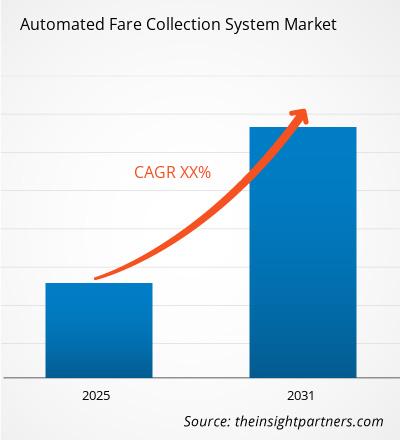预计自动售检票系统市场在 2025 年至 2031 年期间的复合年增长率将达到 XX%,市场规模将从 2024 年的 XX 百万美元扩大到 2031 年的 XX 百万美元。
该报告按组件(硬件、软件)分类,并根据技术平台(智能卡光学字符识别、近场通信)进一步分析市场。它还按应用(公共汽车、收费公路、火车、汽车租赁)考察市场。报告按全球、区域和国家/地区为每个关键细分市场提供全面的细分。该报告包括所有细分市场的规模和预测,以美元表示。它还提供了主要参与者当前市场状况的关键统计数据,以及对当前市场趋势和新兴机遇的洞察。
报告目的
Insight Partners 撰写的《自动票价收集系统市场》报告旨在描述当前格局和未来增长、主要驱动因素、挑战和机遇。这将为各种业务利益相关者提供见解,例如:
- 技术提供商/制造商:了解不断变化的市场动态并了解潜在的增长机会,使他们能够做出明智的战略决策。
- 投资者:对市场增长率、市场财务预测和整个价值链中存在的机会进行全面的趋势分析。
- 监管机构:规范市场政策和警察活动,以尽量减少滥用,维护投资者的信任和信心,并维护市场的完整性和稳定性。
自动售检票系统市场细分组件
- 硬件
- 软件
技术平台
- 智能卡光学字符识别
- 近场通信
应用
- 公交车
- 收费站
- 火车
- 汽车租赁
您将免费获得任何报告的定制,包括本报告的部分内容,或国家级分析、Excel 数据包,以及为初创企业和大学提供超值优惠和折扣
自动售检票系统市场: 战略洞察

- 获取本报告的主要市场趋势。这个免费样本将包括数据分析,从市场趋势到估计和预测。
自动售检票系统市场的增长动力
- 彻底改变旅行方式:自动售检票系统的兴起
- 无缝旅程:AFC 系统如何提升通勤体验
- 智能解决方案:采用 AFC 技术的公共交通的未来
自动售检票系统市场的未来趋势
- 自动售检票系统正在兴起!
- 无缝旅行:自动售检票的未来正在等待
- 彻底改变交通方式:售检票技术的市场机遇
自动售检票系统的市场机遇
- 无缝旅行:智能售检票系统的兴起
- 无现金通勤:自动化如何改变公共交通
- 个性化旅程:城市交通票价系统的未来
自动售检票系统市场区域洞察
The Insight Partners 的分析师已详尽阐述了预测期内影响自动售检票系统市场的区域趋势和因素。本节还讨论了北美、欧洲、亚太地区、中东和非洲以及南美和中美洲的自动售检票系统市场细分和地域分布。
自动售检票系统市场报告范围
| 报告属性 | 细节 |
|---|---|
| 市场规模 2024 | US$ XX million |
| 市场规模 2031 | US$ XX Million |
| 全球复合年增长率 (2025 - 2031) | XX% |
| 历史数据 | 2021-2023 |
| 预测期 | 2025-2031 |
| 涵盖的领域 |
By 组件
|
| 覆盖地区和国家 | 北美
|
| 市场领导者和主要公司简介 |
|
自动售检票系统市场参与者密度:了解其对业务动态的影响
自动售检票系统市场正在快速增长,这得益于终端用户需求的不断增长,而这些需求的驱动因素包括消费者偏好的演变、技术进步以及对产品优势的认知度的提升。随着需求的增长,企业正在扩展其产品线,不断创新以满足消费者需求,并抓住新兴趋势,从而进一步推动市场增长。

- 获取 自动售检票系统市场 主要参与者概述
主要卖点
- 全面覆盖:本报告全面涵盖了对自动售检票系统市场的产品、服务、类型和最终用户的分析,提供了整体格局。
- 专家分析:本报告基于对行业专家和分析师的深入了解而编写。
- 最新信息:由于报告涵盖了最新信息和数据趋势,因此确保了业务相关性。
- 定制选项:此报告可以根据特定客户要求进行定制,并恰如其分地适应业务策略。
因此,关于自动售检票系统市场的研究报告可以帮助引领解码和理解行业情景和增长前景的线索。尽管可能存在一些合理的担忧,但本报告的总体优势往往大于劣势。
- 历史分析(2 年)、基准年、预测(7 年)及复合年增长率
- PEST和SWOT分析
- 市场规模、价值/数量 - 全球、区域、国家
- 行业和竞争格局
- Excel 数据集
近期报告
客户评价
购买理由
- 明智的决策
- 了解市场动态
- 竞争分析
- 客户洞察
- 市场预测
- 风险规避
- 战略规划
- 投资论证
- 识别新兴市场
- 优化营销策略
- 提升运营效率
- 顺应监管趋势




















 获取免费样品 - 自动售检票系统市场
获取免费样品 - 自动售检票系统市场